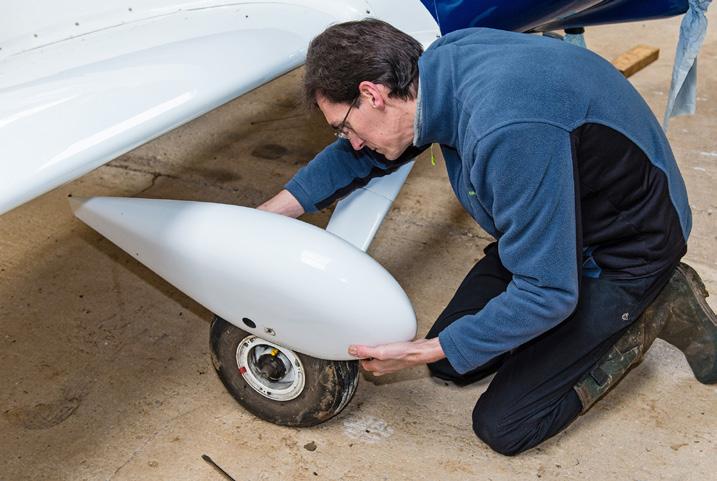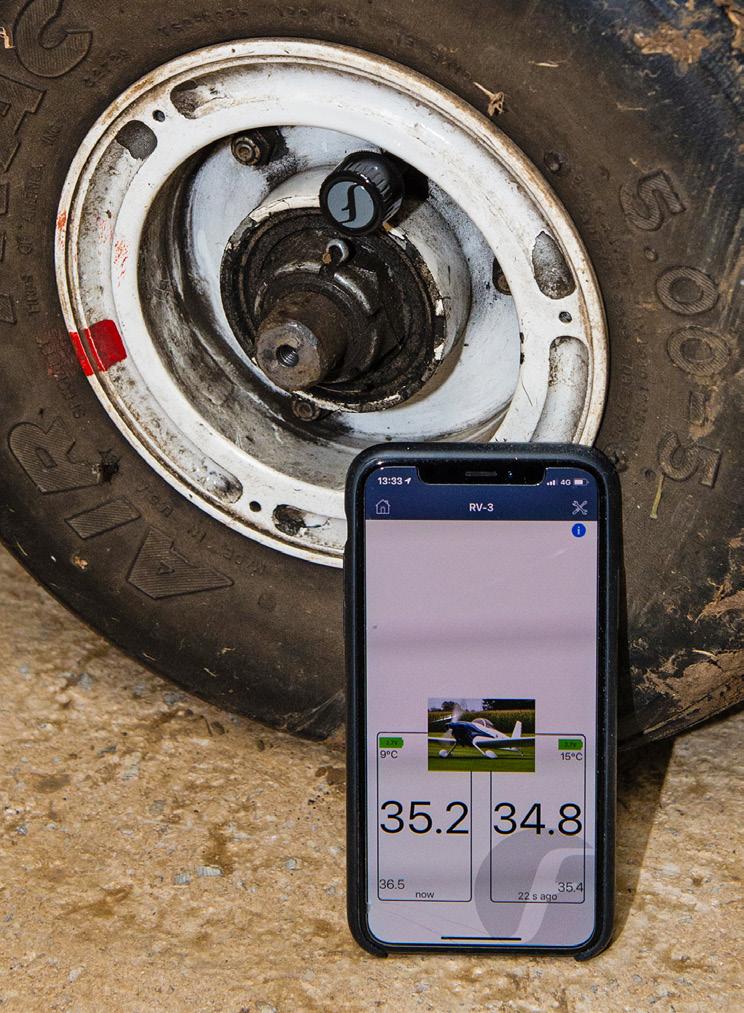
6 minute read
Top Gear
The latest aviation kit, impartially tested and evaluated
ATPMS Tyre Pressure Monitor
Advertisement
**** | From €99 | Supplier www.aviation-tpms.de
If you don’t have spats, particularly the close-fitting variety found on aircraft like Van’s Aircraft types, then I can already guess some readers will have started to roll their eyes at the idea of using some Bluetooth-enabled remote sensors to monitor their tyre pressures. When our Safety Editor Steve Ayres previewed these in last issue’s Safety Kit section, a highly polarised discussion soon began on the FLYER Forum with some claiming all they needed was the Mark One eyeball and a footpump.
Well that’s true, but I was a little more curious than that, and figured they were worth taking a look at. Our test items turned up just as the most recent restrictions came along, so I’m afraid that’s prevented me from taking them flying, so my testing so far has been restricted to terra firma.
Tyres and tubes last longer if correctly inflated and as good quality tyres and tubes aren’t cheap, keeping them topped up will help maximise that investment. A large majority of tyre problems arise from continued use at below optimum pressure. By the time a tyre looks soft at pre-flight, particularly one lurking under a wheel fairing, then it’s probably seen a good bit of use at below specified pressure. In the case of my RV-3, by the earliest time I can visually discern if a tyre might need some air, it measures around 20psi when I put the pump on. I usually run mine at around 35psi, so that’s a good amount down.

Installation meant having to remove the wheel's close-fitting wheel fairing
German firm ATPMS doesn’t disguise the fact that it uses FOBO Bike 2 sensors for their aviation offering. Googling reveals the product is very popular with motorcyclists, and that in general they are regarded as robust and reliable. The current Bike 2 being the latest development of an earlier Bike 1 sensor set.
Out of the box they feel decent quality. The sensor is 20mm in diameter and 16mm deep – they will send you a dummy unit to try if you’re unsure about your particular setup. A screw cap that allows access to change the battery (a CR-1632 button-style unit) is sealed with an O-ring which helps keep the electrical bits dry and dust-free.

Sensor cap unit is sealed to resist dust and moisture and is powered by a button-style battery.
Once you’ve downloaded the app which runs on either Apple or Android, getting set up is easy. Well, it is if you have direct access to your wheels. My RV-3 has the original Van’s single-piece wheel spats, and access to the tyre valve is difficult unless the spat is removed. I can add air to the tyres thanks to a removable grommet, but it still takes an extended socket and a valve extension before you’re near close enough to begin adding air with a pump. So I removed the spats. Eyeing the size of the sensor, I did wonder if it was going to easily fit on the valve stem without fouling the sides of the wheel, but there were no issues.
With the app open and running, you replace your standard valve dust cap with one of the FOBO caps. Once it’s screwed on securely, you touch your phone to the sensor and the two devices pair via Bluetooth. Once you’ve fitted sensors to all your wheels, you select a profile (the best match to the RV-3 was a trailer… luckily you can add your own image so the humiliation was short lived… ) and set your minimum, regular and maximum tyre pressures.
While I didn’t put my spats back on – they’re staying off for some pre-Permit renewal work, I did have a good look at the rotational path of the valve, to make sure when the spats are refitted, there was nothing it could catch on as it turns.
The manufacturer recommends 10mm minimum clearance, and I think that’s the minimum you’d want.

Pressure pre-sets are easy to set to your typree's requirements

Individual graphs of pressure and temperature can be called up for each tyre

The app automatically interrogates the sensors each time you arrive at the aircraft
Initial thoughts are that it’s interesting to see the difference between the air pressure my foot-pump indicates and what the sensors measure. Granted, it’s a no-thrills unit from Amazon, but I needed to set the tyres to 39psi to get 35 shown on the sensors. There’s no problem taking them on and off to add air to the tyres, by the way, you treat them just like regular caps. On arriving at the aircraft, the app interrogates the sensors and tells me tyre pressure and temperature. Leave the app running and you’ll be able to monitor pressure in real time from the cockpit during flight and if there’s a leak, you’ll get an alert.
And it does work. Loosening a cap very slightly to simulate a leak, the app displayed a pressure update every 30 seconds, and at my assigned minimum pressure setting, I was given a visual and audio alert. I inflated the tyre and tried it again while SkyDemon ran in the foreground, and the alerts still popped up from behind that.
Returning to the aircraft after you’ve been away for a while, and the app reconnects with no prompting. Besides the live monitoring, you can also review graphs of tyre pressure and temperature over time, plus there’s a visual battery level indicator – actual battery life is quoted as up to one year.
Something that had been discussed on the forum thread mentioned earlier was that in replacing the dust cap with the sensor, you’re removing a level of security against tyre deflation should the valve fail. Well the sensor cap is a still a cap nonetheless, so that shouldn’t be an issue.
What does play on my mind is that in keeping the valve open to a degree so that it can live-sense the pressure, is that going to be a problem? Reading the wider user community’s experiences online, that doesn’t seem to be the case. If you know better, please let me know!
Something that’s particular to my setup is, that while the ATPMS will allow me to monitor tyre pressures more accurately, the sensor caps would mean I’d have to take the spats off each time I need to add air – There’s no way my current valve access would work with the bigger caps. That may be no bad thing, as it promotes a more thorough inspection once in a while.
When we first mentioned this system, I was contacted by a FLYER reader and aircraft engineer with an RV-7 that’s been assessing similar systems. He’s settled on a different unit that has an in-cockpit display, and is cleverly self-powering. We’ll likely be taking a look at that in future.
While he too recognises that pressure monitors might not be for everybody, aside from similar access issues for pressure checks, he mentioned that he often operates into narrow and remote strips, and therefore likes knowing in advance (in flight) if a potential tyre problem might have occurred since take-off. If it does, he can divert to somewhere with better facilities for landing and fixing the problem, potentially avoiding getting stuck somewhere, or worse a runway excursion somewhere with little margin for error.
ATPMS aren’t cheap at €99 for the two sensor kit or €149 for the three sensor kit, and obviously they’re not certified either. Yes, as discussed on the forum, simple works. But I can see the benefits of the system as a way to keep an eye on tyres, especially those that live under tightly fitted fairings.








